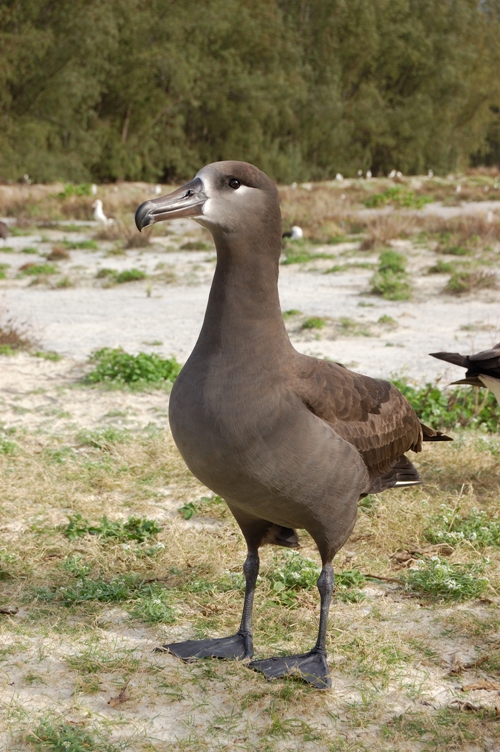| New Photos | Animal News | Animal Sounds | Animal Movies | Upload Photo | Copyright | Korean |
|---|
| Funny Animal Photos | Monsters in Animalia | Wiki Articles Fun Facts about Animals | Links | Home | Mobile A.P.A. |
|---|
| Image Info | Original File Name: Black-footed Albatross (Phoebastria nigripes) 1.jpg Resolution: 500x752 File Size: 329795 Bytes Date: 2007:02:25 14:32:50 Camera: NIKON D40 (NIKON CORPORATION) F number: f/5.5 Exposure: 3125/1000000 sec Focal Length: 48/1 Upload Time: 2007:12:14 11:42:36 | |
| Author | Name (E-mail): Unknown | |
| Subject | Black-footed Albatross (Phoebastria nigripes) - Wiki | |
 |
| Email : E-Card | Poster | Web Master Delete Edit Info Admin |
| Description | Black-footed Albatross (Phoebastria nigripes) - Wiki
Black-footed Albatross
The Black-footed Albatross, Phoebastria nigripes, is a large seabird from the North Pacific. It is one of three albatross that range in the northern hemisphere, nesting on isolated tropical islands. Description The Black-footed Albatross is a small member of the family (while still large compared to most other seabirds) that has almost all black plumage. 10% of individuals have white feathers at the base of the tail, and all adults have white markings around the base of the beak and below the eye. Its beak and feet are also all dark. They average at about 81 cm (32 in) in length, weigh about 3.3 kg (7.4 lbs) and have a wingspan of 2.1 m (6.9 ft). Behavior and Range Range The Black-footed Albatross, along with the Laysan Albatross and the rare Short-tailed Albatross, are the three species of albatross that range in the northern hemisphere, as opposed to the rest of the family which range from the Equator south. They nest colonially on isolated islands of the Northwestern Hawaiian Islands (such as Laysan and Midway), and the Japanese islands of Toroshima Island, Bonin, and Senkaku. Their range at sea varies during the seasons (straying farther from the breeding islands when the chicks are older or they don't have chicks) but they make use of great areas of the North Pacific, feeding from Alaska to California and Japan. They overlap greatly in breeding and feeding range with the other two species of northern albatross, although the other two will range further north into the Bering Sea than the Black-footed will. Breeding The Black-footed Albatross, like the rest of its family, forms long term pair-bonds that last for life. After fledging the birds return to the colony after three years, and spend two years building nests, dancing and being with prospective mates, a behaviour that probably evolved to ensure maximum trust between the birds (raising an albatross chick is a massive energetic investment, and a long courting period establishes for both birds that the other is committed). Nests are simple depressions scraped in the sand, into which one egg is laid. The egg is incubated for just over two months (65 days). Both birds incubate the egg, the male incubating more as the female leaves soon after hatching to recoup reserves used for egg-laying. The average time spent on incubating shifts is 18 days. However, mates can wait up to 38 days to be relieved, and if something happens to the mate the other has been recorded incubating for 49 days without food or water. The chick is brooded for 20 days by its parents, after which both parents leave the nest and return to feed the chick. The chick is fed regurgitated food by sticking its bill inside that of its parent. Fledging occurs after 140 days. Feeding The Black-footed Albatross feeds in pelagic waters, taking fish, mostly the eggs of flying fish, squid and to a lesser extent crustaceans. It has been described as a 'floating pig' by one author for its habit of taking kitchen scraps from ships. It will also consume floating debris, including plastics. Conservation The Black-footed Albatross is considered endangered, because it is taken incidentally by long-line fishing. An estimated 4,000 are taken every year, based on the number taken in 1990; other estimates put the number at 8,000. It is also vulnerable to oil and ingestion of floating plastics, which reduces the space in the stomach available for food to be brought to the chick. All of its nesting sites in the U.S. are protected. http://en.wikipedia.org/wiki/Black-footed_Albatross
| |||
| Copyright Info | AnimmalPicturesArchive.com does not have the copyright for this image. This photograph or artwork is copyright by the photographer or the original artist. If you are to use this photograph, please contact the copyright owner or the poster. |
|
|
|
| |||||||
| CopyLeft © since 1995, Animal Pictures Archive. All rights may be reserved. | ||||||||
Stats